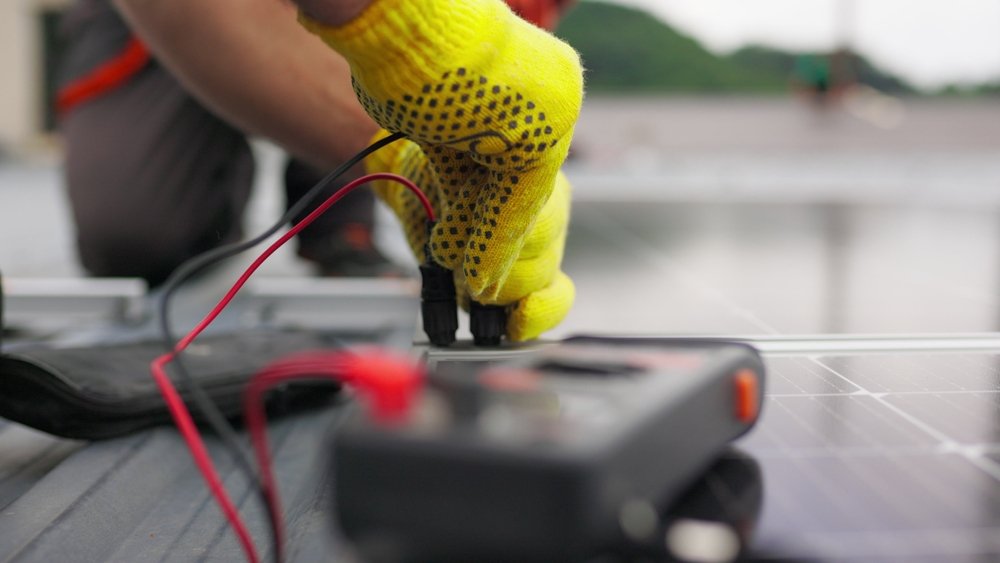What is solar voltage drop?
What is solar voltage drop?
Voltage drop is the reduction in voltage that happens as DC current flows through a cable with resistance. The longer and thinner the cable (and the higher the current), the more volts you lose before the power reaches your charge controller, inverter, batteries, or load (e.g., a pump).
Why it matters
- Lower performance & yield – panels, pumps, inverters and MPPTs see less voltage, so they deliver less power.
- Nuisance shutdowns – inverters and pumps can trip on under‑voltage.
- More heat, less safety margin – undersized cables run hotter.
- Money loss – you paid for watts you never get to use.
2) The physics (don’t worry, it’s simple)
Ohm’s Law: Vdrop=I×RV_\text{drop} = I \times RVdrop=I×R
Where:
- III = current in Amps
- RRR = total loop resistance of the cable (out and back) in Ohms
Cable resistance: R=ρ×2LAR = \rho \times \frac{2L}{A}R=ρ×A2L
Where:
- ρ\rhoρ = resistivity of the conductor (for copper ≈ 0.0175 Ω·mm²/m at 20 °C)
- LLL = one-way length in meters (m)
- AAA = cable cross‑section in mm²
- 2L because current travels to the load and back (in DC systems)
Percentage voltage drop: %Drop=VdropVsystem×100\%\text{Drop} = \frac{V_\text{drop}}{V_\text{system}} \times 100%Drop=VsystemVdrop×100
Common rule of thumb:
- Try to keep DC voltage drop ≤ 3% between modules → MPPT.
- ≤ 2–3% for battery ↔ inverter and critical loads (pumps, medical, telecom).
- Total system drop ideally ≤ 5% end-to-end.
3) Quick resistance reference (copper)
Approximate loop resistance (out + back) per meter for common sizes:
| Cable size (mm²) | R (Ω per km, one-way) | R loop per meter (Ω/m) |
|---|---|---|
| 2.5 | 6.9 Ω/km | 0.0138 |
| 4 | 4.3 Ω/km | 0.0086 |
| 6 | 2.88 Ω/km | 0.00576 |
| 10 | 1.72 Ω/km | 0.00344 |
| 16 | 1.08 Ω/km | 0.00216 |
(Values rounded; temperature increases resistance slightly.)
4) How to size your solar DC cables (step-by-step)
- List the current (A) that will flow in that run.
- From panels to MPPT: use panel Isc × number of parallel strings × a safety factor (typically 1.25).
- From batteries to inverter or to loads: use maximum expected current.
- Measure the one-way length (m).
- Don’t guess. Walk it, measure it, or read from drawings.
- Pick an acceptable voltage drop % (commonly 2–3% for critical runs).
- Rearrange the formula to solve for cross-section AAA: A=2×L×I×ρΔVallowA = \frac{2 \times L \times I \times \rho}{\Delta V_\text{allow}}A=ΔVallow2×L×I×ρ Where ΔVallow=%Drop×Vsystem\Delta V_\text{allow} = \%\text{Drop} \times V_\text{system}ΔVallow=%Drop×Vsystem.
- Choose the next bigger standard size (e.g., 4, 6, 10, 16 mm², etc.).
5) The rules of thumb you gave (confirmed)
Use the correct cable thickness (mm²) for the distance and current (A).
Higher current + longer distance ⇒ thicker cable.
Worked mini-examples
- 10 A over 10 m ⇒ 4 mm² (good practical pick at 12/24/48 V systems to keep ≤~3%).
- 20 A over 20 m ⇒ 10 mm² (again, practical to keep drop low).
These line up with good engineering practice.
6) Kenya example (realistic + fully calculated)
Scenario: You’re installing a 1 HP solar water pump (≈ 746 W) 30 m from the PV array/MPPT. Let’s assume it’s a 48 V DC side carrying ~20 A (allowing for efficiency and starting currents).
- One-way length LLL = 30 m → loop length = 60 m
- Using 2.5 mm² copper (R ≈ 6.9 Ω/km one-way):
- Loop resistance RRR = 0.0138 Ω/m × 30 m = 0.414 Ω
- Vdrop=I×R=20×0.414=8.28 VV_\text{drop} = I \times R = 20 \times 0.414 = 8.28 VVdrop=I×R=20×0.414=8.28 V
- %Drop = 8.28 / 48 × 100 ≈ 17.3% (≈ “up to 20%” loss → wasted power)
Switch to 6 mm²:
- R loop per meter ≈ 0.00576 Ω/m
- R=0.00576×30=0.1728 ΩR = 0.00576 \times 30 = 0.1728 ΩR=0.00576×30=0.1728 Ω
- Vdrop=20×0.1728=3.46 VV_\text{drop} = 20 \times 0.1728 = 3.46 VVdrop=20×0.1728=3.46 V
- %Drop ≈ 7.2% (better, but still high for a critical pump)
Switch to 10 mm²:
- R loop per meter ≈ 0.00344 Ω/m
- R=0.00344×30=0.1032 ΩR = 0.00344 \times 30 = 0.1032 ΩR=0.00344×30=0.1032 Ω
- Vdrop=20×0.1032=2.06 VV_\text{drop} = 20 \times 0.1032 = 2.06 VVdrop=20×0.1032=2.06 V
- %Drop ≈ 4.3% (much better; near the 3–5% design window)
Takeaway: That 2.5 mm² cable can throw away a big chunk of your pump power. Jumping to 6 mm² or 10 mm² drastically improves performance and reliability.
7) Fast cheat‑sheet (ballpark picks)
(For copper DC runs, aiming ≲3–5% drop. Always calculate for your exact case!)
| Current (A) | One-way Distance (m) | Suggested mm² |
|---|---|---|
| 10 | 10 | 4 |
| 10 | 20 | 6 |
| 15 | 15 | 6 |
| 20 | 20 | 10 |
| 30 | 15 | 10 |
| 30 | 30 | 16 |
Pro Tip: When in doubt, go up one size—it’s cheaper than losing power forever or replacing burnt cables.
8) Don’t forget these practical factors
- Temperature – Kenya’s heat raises cable resistance; allow margin.
- Conduit grouping – Multiple cables together = less cooling = consider upsizing.
- Aluminium vs copper – Aluminium is cheaper but has higher resistance; you’ll need larger sizes.
- MC4 / connectors / lugs – Underrated or poorly crimped connectors add extra resistance and heat.
- Future expansion – Slight oversizing now saves rework later.
- DC vs AC – This guide focuses on DC strings and low‑voltage DC loads. AC pumps at higher voltage may tolerate longer distances with smaller cables for the same power (because current is lower). Still, calculate!
9) A simple workflow to give your technician
- Map the exact cable routes (measure distances!).
- Compute current on each run.
- Pick the max acceptable % drop for each segment (e.g., 2–3%).
- Use the formula (or a cable sizing calculator) to get the minimum mm².
- Round up to the next standard size and confirm breaker/fuse ratings match.
- Document it in your design so any future technician knows what you did (and why).
10) TL;DR Summary (use this in your proposals & quotes)
- Long cables = power loss.
- Higher current & longer distance ⇒ thicker cable.
- Aim for ≤3% voltage drop on critical DC runs; ≤5% total is a good overall target.
- Kenya pump example: 2.5 mm² over 30 m at ~20 A can waste ~17–20% of your power. Go 6–10 mm² instead.
- Always ask your solar installer/technician to calculate voltage drop using your actual current, voltage, and distances.



